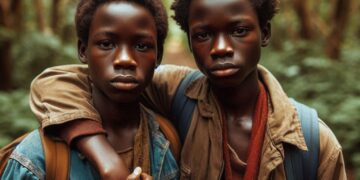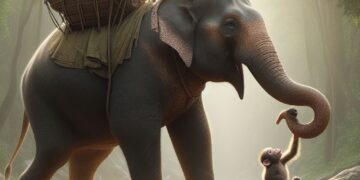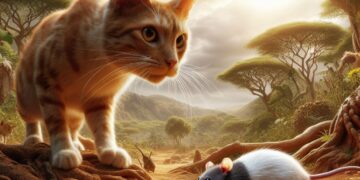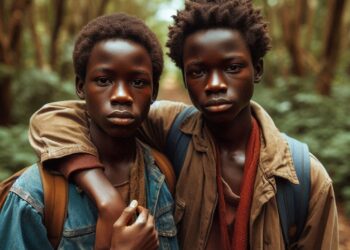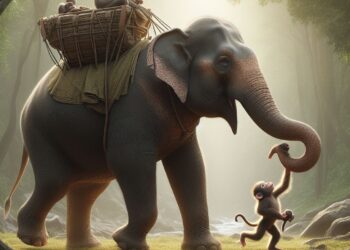In the late 19th century, the land now known as Uganda was a place of ancient traditions, powerful kingdoms, and a landscape untouched by the mechanical marvels of the outside world. The Baganda people lived under the rule of their Kabaka, tending to their lands and practicing the customs passed down through generations. Yet, change was on the horizon—an unstoppable force heralded by strange whispers from the east.
In a small village nestled in the hills, there lived an elder known as Mukajanga, revered as a prophet among his people. Mukajanga was known for his visions, which were said to be gifts from the spirits of the ancestors. He was a man of wisdom, his hair white as the snows of Mount Elgon, and his voice carried the weight of generations.
The Vision of the Iron Serpents
One night, under the light of a crescent moon, Mukajanga had a dream that would shake the foundations of his world. He stood on a high cliff overlooking the vast plains of Buganda, the land bathed in the soft glow of dawn. As he watched, two enormous serpents, their bodies glinting like iron, slithered across the horizon. Their scales shimmered in the early light, and as they moved, the earth trembled under their weight. The serpents were not alive; they were cold, metallic, and they wound through the land with an eerie precision.
As Mukajanga looked closer, he saw that these serpents carried strange burdens—boxes of iron that clattered and roared as they moved. The serpents brought with them men of pale skin, speaking in tongues unknown to Mukajanga, and they bore weapons that spat fire and death. Behind them, the land changed: forests were felled, rivers were bridged with stone and steel, and the huts of his people gave way to structures of brick and iron.
In his dream, Mukajanga tried to cry out a warning, but his voice was drowned by the roar of the serpents and the clanging of their burdens. The land was no longer quiet; it was filled with the sounds of sawmills, the cries of displaced animals, and the weeping of his people. The serpents brought something more than physical change—they brought a new era, one that threatened to devour the old ways entirely.
The Tales from the East
When Mukajanga awoke, his heart was heavy with the weight of his vision. He knew that the spirits had shown him a future filled with danger and transformation. Gathering the elders of the village, Mukajanga shared his dream, and his voice trembled as he spoke of the iron serpents and the pale-skinned men who would bring them.
“The spirits have spoken to me,” Mukajanga said, his voice echoing in the stillness of the night. “They warn of serpents made of iron, creeping into our lands from the east. They will bring with them men who do not know our ways, who will seek to change our land and our lives forever.”
The elders listened in silence, their faces etched with concern. They had heard tales of strange men from the east, men who had begun to appear in the lands beyond Lake Nalubaale (now known as Lake Victoria). These men were building something that cut through the earth, something that was neither road nor river but seemed to carry great power. The elders had dismissed these stories as the exaggerations of travelers, but Mukajanga’s vision filled them with a deep unease.
Then, one day, a weary traveler arrived in the village, bringing with him stories that chilled the blood. He spoke of the lands near a great river called Tsavo, where men were building the iron serpents. But the work was plagued by terror—two lions, massive and without fear, had been hunting the men as they worked. These beasts, known as the Man-Eaters of Tsavo, were unlike any other. They seemed to possess a malevolent intelligence, striking under the cover of night, dragging workers from their tents, and spreading fear among all who heard their roars.
The traveler described how the men, both African and European, were gripped by dread, seeing these lions as more than mere animals. Some said they were spirits of the land, angered by the invasion of the iron serpents. Others believed they were curses brought by the white men, a dark omen of the suffering that would come if the serpents continued their march into the heart of Africa.
Mukajanga listened to these stories with grave concern. The lions, he realized, were another sign—a manifestation of the turmoil that the iron serpents would bring. They were not just predators; they were symbols of the natural world’s rebellion against the foreign invaders.
The Prophet’s Call
Days turned into weeks, and soon the tales from the east became more frequent. The iron serpents Mukajanga had seen in his dream were indeed real. The British were building a railway, a long line of metal tracks that would stretch from the Great Sea to the very heart of their land. The serpents, as Mukajanga called them, would soon cross into Buganda, bringing with them a wave of foreign influence and control.
Mukajanga, now seen as a seer by his people, began to rally the villages. He traveled from hill to hill, calling for unity among the clans. He warned that the serpents would bring a new way of life, one that would destroy the traditions and the sacred relationship with the land. He called upon the spirits of the ancestors to guide them in these dark times and to give them strength to resist the coming storm.
But not all heeded Mukajanga’s warnings. Some, tempted by the promises of wealth and power that the foreigners offered, began to align themselves with the new order. Chiefs and elders debated fiercely, torn between preserving their ways and embracing the change that seemed inevitable.
The Final Vision
As the iron serpents drew nearer, Mukajanga’s visions grew darker. He saw the forests of Buganda, once filled with the songs of birds and the rustling of leaves, now replaced by fields of foreign crops and the drone of machinery. He saw his people, once proud and free, toiling under the yoke of a distant ruler, their voices silenced by the weight of foreign laws.
In one final vision, Mukajanga saw a great battle—a struggle not fought with spears or arrows, but with hearts and minds. He saw his people standing at the crossroads, faced with a choice: to resist the serpents and risk everything or to submit and lose their very soul.
On the day the first iron serpent crossed into Buganda, Mukajanga stood upon the same cliff from his dream. The metal beast roared as it cut through the land, a symbol of the unstoppable tide of change. But Mukajanga did not despair. He knew that while the serpents might change the land, the spirit of the people could not be so easily conquered.
Turning to his followers, Mukajanga spoke with the voice of a prophet. “The serpents may bring change,” he said, “but they cannot change who we are. Our roots are deep in this land, and as long as we remember our ancestors and honor our spirits, we will endure. The serpents may come, but they will never break us.”
Legacy of the Serpents
And so, the story of the iron serpents, the Man-Eaters of Tsavo, and the prophet of the hills became a tale passed down through generations. It was a story of resistance, of the struggle to maintain identity in the face of overwhelming change. Mukajanga’s name became a symbol of the enduring spirit of the Baganda people, a reminder that even in the darkest times, there is always a light that cannot be extinguished.
As the years passed, the railway did bring profound changes to Buganda, but Mukajanga’s legacy lived on. The iron serpents had come, as the prophet foretold, but the heart of the people remained strong, rooted in the land that had always been theirs.
The Man-Eaters of Tsavo, those fearsome lions who once terrorized the railway builders, became legends in their own right. To the people of Buganda, they were seen as the spirits of the land, guardians who resisted the encroachment of the iron serpents. Their story, intertwined with Mukajanga’s prophecy, served as a reminder of the power of the natural world and the spirits that watched over the land.

